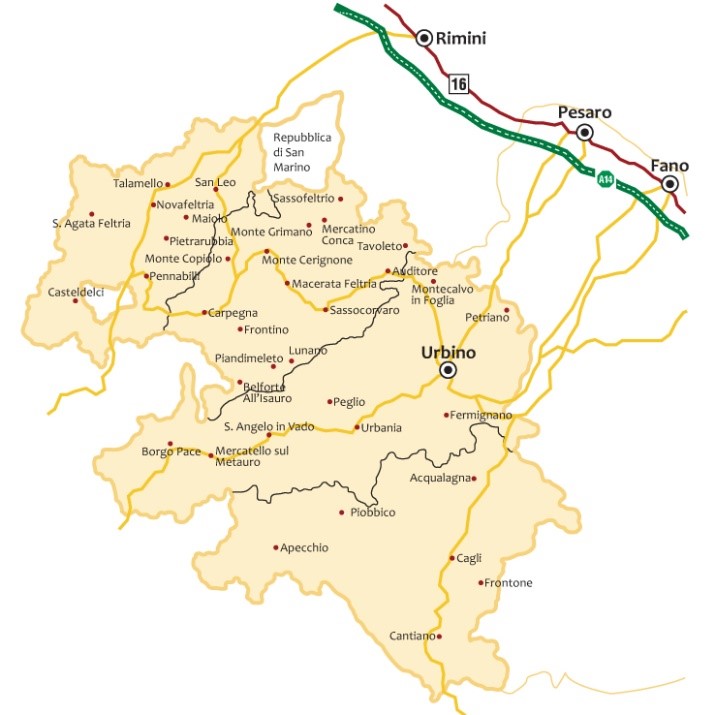The Montefeltro is a geographical area located in the hinterland of the Marche, precisely in the province of Pesaro-Urbino. The area is situated between the regions of Umbria, Tuscany, Emilia-Romagna and the Republic of San Marino. It is made up of 35 municipalities grouped into four mountain communities: Montefeltro, AltaValmarecchia, Alto e Medio Metauro, Catria and Nerone. The Montefeltro is an area of rare beauty and rich in culture. Its ideal capital is the magnificent Renaissance city of Urbino, listed by Unesco as a World Heritage Site. The harmonious relationship between Earth and Man has produced long-lived results. Man has reaped, grown, transformed and protected the fruits of this land for ages
The Montefeltro
Situated at the crossroads between historic streets, the area boasts a variety of environment and landscape.At every passage and change of direction, the landscape and natural setting vary: from the rugged mountains of Sasso Simone, Simoncello and Mount Carpegna to the majestic and imposing ones of Catria and Nerone, through the greener and more densely forested mountains of the Alpe della Luna till the soft hills descending towards the Adriatic Sea. Works of man have made connections easier and more comfortable. In the Montefeltro the hospitality and leisure system is extensive and widespread. Acqualagna, Apecchio, Auditore, Belforte all’Isauro, Borgo Pace, Cagli, Cantiano, Carpegna, Casteldelci, Fermignano, Frontino, Lunano, Macerata Feltria, Maiolo, Mercatello sul Metauro, Mercatino Conca, Monte Calvo in Foglia, Montecerignone, Montecopiolo, Montegrimano, Novafeltria, Peglio, Pennabilli, Petriano, Piandimeleto, Pietrarubbia, Piobbico, San Leo, Sant’Agata Feltria, Sant’Angelo in Vado, Sassocorvaro, Sassofeltrio, Talamello, Tavoleto, Urbania, Urbino.This is the list in alphabetical order of the municipalities making up the Montefeltro.

Urbino
The city of Urbino is linked to the memory of the Duke Federico of Montefeltro.The city boasts the Ducal Palace with its sober elegance , the ups and downs of the streets and lanes with sudden glimpses of the Montefeltro. However, the city of Urbino is not only the one worth mentioning. Its Renaissance splendour is reflected in the small villages nearby, in the many churches and abbeys, in the rural houses and dove-cotes.The typical features of the Montefeltro architecture are the red terracotta with its bourgeois elegance and the solid quarry stones of the buildings perched next to each other. In every town a palace, a castle, a residence, a fortress reminds us of the nobility of the households owning the place: private wealth and protection of the community. The Montefeltro has well preserved its various identities and this proves that this land has never experienced abandonment, but has witnessed a sequence of ages which have left their mark.It’s a journey full of history which is still clearly visible.
ENOGASTRONOMY
The "Crescia Sfogliata" (a kind of puff pastry flatbread)
It is very similar to the Piadina Romagnola (a flatbread from Romagna) but it differs for its dough enriched with eggs and pepper, which makes it very delicious and pasty. Its flavour is so tasty that you can eat it without adding anything. It goes perfectly with ham and a cheese called “Casciotta of Urbino” but you can also have it with salami, stracchino (soft cheese), squaquerone (another type of soft cheese), herbs of the field cooked in pan or bresaola (dried beef).The so-called “crescia sfogliata” is famous in the area of Urbino, while the “crostolo”(made with eggs and lard) is known in the area of Urbania: its dough is enriched also with polenta made with corn flour.
The "Casciotta d’Urbino"
The real “Casciotta d’Urbino” is made only in the province of Pesaro-Urbino. It is still produced in handicraft way from the expert hands of local dairymen which hand on this ancient techniques from father to son.The very first production regulation was formalized in 1982 and then integrated and modified from origin to Protected Denomination of Origin (D.O.P.), still in force. The first news of the production of this cheese date back to 1400 when Pope Bonifacio IX regulated the cattle drive in the Vatican area and in the Montefeltro accordingly. Documentary evidence proves that the famous Italian artist Michelangelo was sent ham and casciotta from Casteldurante in the mid 1500s. As a matter of fact the famous sculptor was said to be a casciotta lover. The D.O.P. certifications guarantee that the “Casciotta of Urbino” is a product whose organoleptic properties and commercial characteristics mainly come from the environmental conditions and the old production techniques of the area. Of course only products meeting specific requirements will be certified PDO and the “Casciotta of Urbino” is one of them:it is a fat, semi-cooked milk cheese made from a minimum of 70% to a maximum of 80% of full-cream sheep’s milk and from 20/30% of full-cream cow’s milk coming from two daily milkings. This cheese is one of the typical food and wine products of the Marche region (especially of Urbino) ; with its unique flavour it enriches any dish. You can either have it just with rustic bread, perfect for a simple snack, or with ham and eggs or with other dairy products.
IF YOU EVER HAVE THE CHANCE TO VISIT THE MONTEFELTRO JUST MAKE YOUR CHOICE:
YOU CAN EITHER ENJOY ITS ART AND ARCHITECTURE, OR ITS GOOD FOOD AND WINES, OR ITS ENVIRONMENTAL OASES AND NATURE RESERVES OR YOU CAN EXPERIENCE EVERYTHING:
IT’S AN AREA FULL OF WONDERS!
Cycling is one the best ways to fully enjoy an area like the Montefeltro . Visitors will have the opportunity to appreciate the wide range of gems hidden in the area. MARCHE and Bike with its professionalism will provide the services visitors need to discover these gems through a number of guided itineraries.
